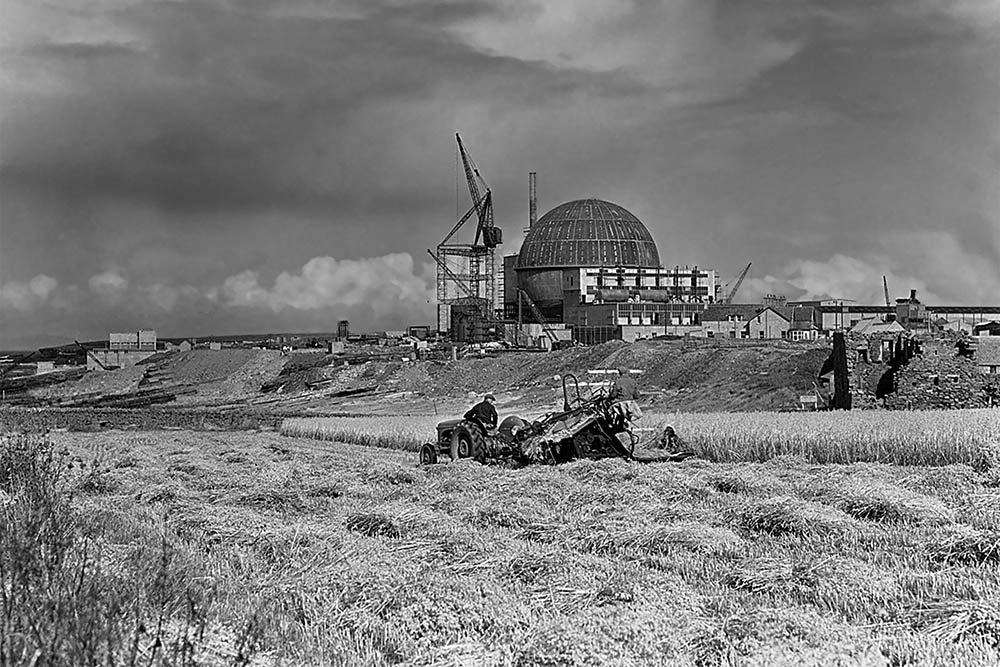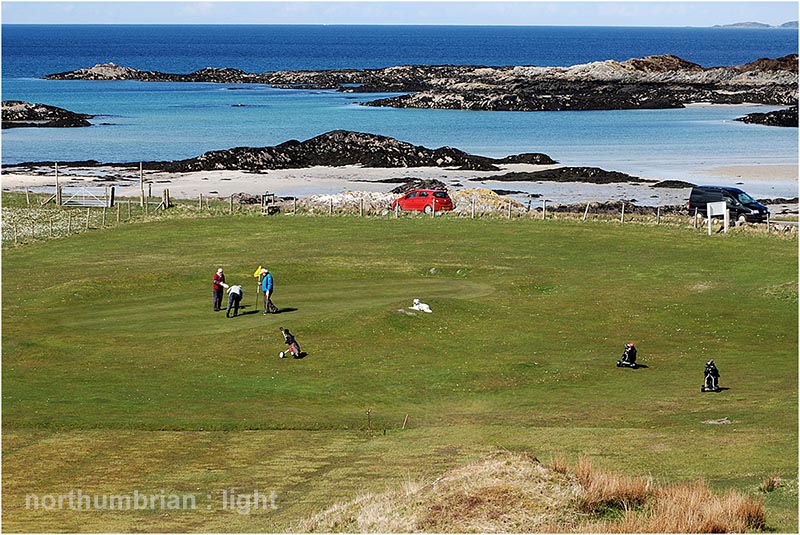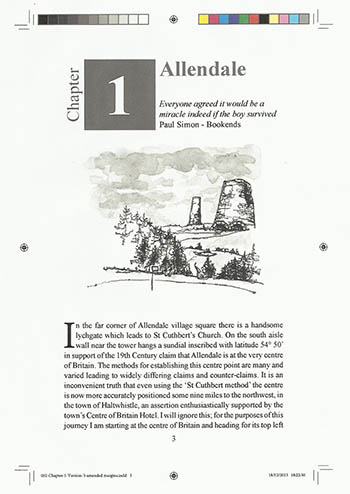… to Selkirk and Innerleithen:
Category Archives: Courses
The sequel
Golf in the Wild – Going Home will be the sequel to the first book and will take the reader back from Durness, the place where the first book finished, to Allendale, the place where the first book started. The route will be entirely different, heading east along the Scottish mainland’s most northerly coast, first stop, Reay Golf Course. This brief extract is a taster from the second chapter:
When I was small and Christmas trees were tall, I was easily spooked by big things. Taken to the local fire station by my grandfather, I was reduced to tears by the sheer enormity of the engines. Given the opportunity to climb Portland Lighthouse, the endless stairs sent me scurrying outside. The railway viaduct near Goostrey in Cheshire towered so high, I would not go near. In the nearby fields an enormous and strange structure was taking shape and I took exception to it. In the 1950s, Bernard Lovell’s radio telescope at Jodrell Bank was only partially complete.
Many years later, living in the foothills of the Peak District at Bosley, on clear days, the entire Cheshire Plain was visible from our bedroom window. And there, at its centre, the Jodrell Bank telescope – no longer something to be feared, no longer a stranger in the landscape, it had come to define it.
Around the same time in the 1950s, many miles further north, a more threatening structure was emerging from the white heat of technology.
At the outbreak of the Second World War it became apparent that the air defences in the far north of Scotland must be improved, primarily as a consequence of the British Navy’s safe anchorage at Scapa Flow which was particularly vulnerable to air attack. As a first step an airfield was constructed at Wick and then later in the war, another at Dounreay. However, the Dounreay facility, not completed until April 1944, was immediately mothballed. Apart from occasional usage by the Navy as HMS Tern II and later as a camp for displaced Polish servicemen, it remained unused until 1954 when the Government announced that Dounreay was to become the centre for UK fast reactor research and development. Between 1955 and 1958, the Dounreay Fast Reactor (DFR) sphere mushroomed into the landscape and, like Jodrell Bank, it has come to define it. Lovell’s creation says ‘here we can reach for the stars’; Dounreay’s says ‘here we can tinker with the tools of Armageddon, tame Einstein’s monster’.
The Caithness Death Star achieved criticality in 1959 and, in 1962, became the first fast reactor in the world to supply electricity to a national grid. Just fifteen years later it was switched off. Since then it has been a long slow process of decommissioning, an exercise that will not complete until 2025 with the demolition of the sphere. Sadly, retention is not practical – according to the Dounreay Heritage Strategy document 2010,SES(09)P007, Issue 2 : The DFR sphere is contaminated throughout and recent core samples from the vault indicate that the concrete has deteriorated more than anticipated and that original construction techniques may have been lax in some areas … despite the most rigorous decontamination efforts, the risk of receiving a significant radiation dose may never go away.
I have some connection with the Dounreay site having been responsible for establishing an Office Systems field trial there between 1988 and 1989, housed in the buildings adjacent to DFR. This exercise had more to do with my love of travel and wild landscape than the practicalities of running a software trial in this faraway place. It was during one of many site visits that I was given access to the sphere, much smaller on the inside than it appears from without. Fortunately I had grown more tolerant of ‘big things’ in the intervening years. Now it is the things I can’t see that worry me, rather than the things I can.
This image from the archive shows Reay’s par 3 7th, Pilkington. Not quite visible, over the horizon to the left, is the DFR sphere:
Three men and a dog
Golf in the Wild has led to some interesting connections both on and off the course. Yesterday (6th December) I spent an enjoyable round at Allendale in the company of the good men of Traigh who loved the wilds of Allendale golf course as much as I love the wilds of Traigh. It reminded me of one glorious Spring day spent researching the book at Traigh when at the ninth I caught up with this happy scene – three men and a dog putting out to finish their round.
This is how the chapter on Traigh ends:
My first holiday romance was at a farmhouse near St David’s in south Wales. I fell for the farmer’s daughter, she was about sixteen and I was barely four. I can still feel her soft hands on my shoulders. She was the first of the gender to make me realise that girls could be loving creatures, unlike my sister, too engrossed in her own older world and my mother, too much in charge. The night the holiday ended, back home, I was distraught, crying a river into Robin-starched sheets. Ever since I have had an overly-moist sentimental streak for people and places left behind. Traigh is such a place.
Durness – Journey’s End
Golf is all about numbers – look at a scorecard and it is covered in them: the holes 1 to 18; the White, Yellow and Red distances for each hole; pars; stroke indexes; gross scores; nett scores; stableford points, handicaps. Non-golfers might be surprised to know that there are GPS systems which tell you exact distances from where your ball has landed to the hole – more numbers.
Golf in the Wild takes you on a journey of 727 miles from Northumberland to the far northwest of Scotland, taking in fifteen courses – assuming you play eighteen at each that is a total of 270 holes and this is what awaits as a finale, on the last course, Durness – what a finish (click on the image to see if you can make out the flag):
This is exactly what the sadistic inventor of golf had in mind when he explained his intentions to Robin Williams – sensitivity warning – those offended by bad language should not watch/listen:
And this image just to prove that I don’t ‘dress like a pimp’ and no wheels are involved – I carry my own bag.

This post was first published at www.northumbrianlight.wordpress.com
InDesign CC
Having finally bitten the bullet and subscribed to InDesign CC, the formatting of the book is slowly taking shape. Starting with a blank sheet of paper is quite a daunting prospect – it seems like it should be easy – the page size is pre-defined, there is guidance on fonts and margins but there is still much to decide. It has taken me three days to get this far – the chapter heading is intended to echo a golf flag and there must be space for all the various course names and quotes, all of which vary in size e.g. Selkirk & Innerleithen. Then there are header and footer/page number options, line spacing, font sizes, footnotes, dropcaps etc etc. The challenge is to be original but professional – it has to “look right”. Hopefully it does.
Some progress
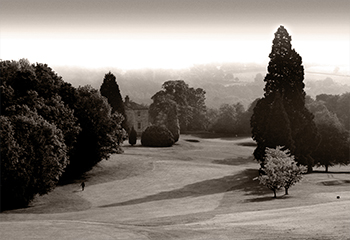 After several months of waiting around for promised responses from publishers – they never did – I am making steady progress towards self-publication. Finding an organisation that is informed, responsive, helpful and UK based has been a trial but they do exist, or at least one does. I am about to start detailed layouts with InDesign CC, I will finalise the text for the umpteenth time and worst of all I need to decide on the photographic content. When researching many of the courses I only got one opportunity for photographs and if that day was dreich, as it was at Durness, then the results could be less than satisfactory. This is one image that will definitely not appear in the book, simply because the course doesn’t – it is Hexham one bright but misty morning in June 2012. Commissioned by the Newcastle Journal to photograph Great Golf Holes of the North, it was possible to respond immediately once the weather conditions were ideal, the course being five minutes from home. Just popping back to Durness when the weather bucks up is not an option.
After several months of waiting around for promised responses from publishers – they never did – I am making steady progress towards self-publication. Finding an organisation that is informed, responsive, helpful and UK based has been a trial but they do exist, or at least one does. I am about to start detailed layouts with InDesign CC, I will finalise the text for the umpteenth time and worst of all I need to decide on the photographic content. When researching many of the courses I only got one opportunity for photographs and if that day was dreich, as it was at Durness, then the results could be less than satisfactory. This is one image that will definitely not appear in the book, simply because the course doesn’t – it is Hexham one bright but misty morning in June 2012. Commissioned by the Newcastle Journal to photograph Great Golf Holes of the North, it was possible to respond immediately once the weather conditions were ideal, the course being five minutes from home. Just popping back to Durness when the weather bucks up is not an option.
Gairloch
 This is one of the most spectacular views on the entire journey. Gairloch’s sixth tee is set high in the trees on the southern borders of the course. Facing out to sea, the aptly named Westward Ho! encompasses the sixth green, the bay which the course embraces and the far mountains of the Skye and the Hebrides. It is a sublime distraction and a real test of golf – go left at your peril!
This is one of the most spectacular views on the entire journey. Gairloch’s sixth tee is set high in the trees on the southern borders of the course. Facing out to sea, the aptly named Westward Ho! encompasses the sixth green, the bay which the course embraces and the far mountains of the Skye and the Hebrides. It is a sublime distraction and a real test of golf – go left at your peril!
Strathtay
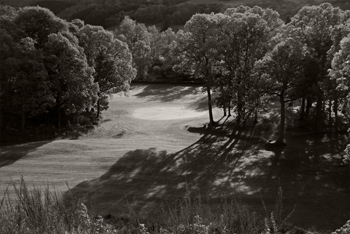 The weather has finally turned in the North East of England but this picture gives me hope. It was taken late October 2011, the sun is low but shining brightly and the autumn-coloured leaves still cling to the trees; there are more golfing days to come this year, hopefully dry ones. This is the view from Strathtay’s third tee with the par 3 green showing as a light patch between the trees. I can think of no other golf hole that climbs quite so steeply in such a short space – everything contrives to leave you breathless.
The weather has finally turned in the North East of England but this picture gives me hope. It was taken late October 2011, the sun is low but shining brightly and the autumn-coloured leaves still cling to the trees; there are more golfing days to come this year, hopefully dry ones. This is the view from Strathtay’s third tee with the par 3 green showing as a light patch between the trees. I can think of no other golf hole that climbs quite so steeply in such a short space – everything contrives to leave you breathless.
Inveraray Castle
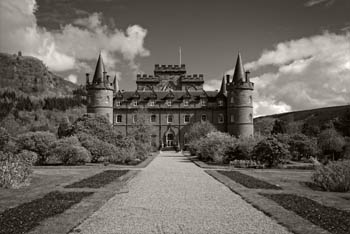 The course once played around the castle at Inveraray, on the other side of the view shown in this picture. Much in the way the town was relocated by the 3rd Duke of Argyll on aesthetic considerations, the 10th and 11th descendants took a similarly dismal view of the great unwashed playing golf in the Castle grounds. The course remained closed until 19th June 1993 when it was re-opened by the 12th Duke at an appropriate distance from the castle, on the southern side of town. The artist’s impression of the course at the beginning of the Inveraray chapter portrays the Castle overlooking the first – a slightly misleading juxtaposition.
The course once played around the castle at Inveraray, on the other side of the view shown in this picture. Much in the way the town was relocated by the 3rd Duke of Argyll on aesthetic considerations, the 10th and 11th descendants took a similarly dismal view of the great unwashed playing golf in the Castle grounds. The course remained closed until 19th June 1993 when it was re-opened by the 12th Duke at an appropriate distance from the castle, on the southern side of town. The artist’s impression of the course at the beginning of the Inveraray chapter portrays the Castle overlooking the first – a slightly misleading juxtaposition.
A little piece of heaven
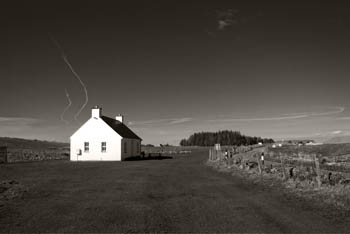 If asked to name my favourite course from the book I would probably have to say it is Traigh. My opinions may be different had I arrived on a soggy dreich day but on both occasions I have washed up on its shores the conditions have been perfect, none more so than on my first visit. This photograph of the but’n’ben style clubhouse was taken in the early morning as I hunted for somewhere to pay my green fees. The skies were a near-flawless clear blue except for the scars of long-spent vapour trails.
If asked to name my favourite course from the book I would probably have to say it is Traigh. My opinions may be different had I arrived on a soggy dreich day but on both occasions I have washed up on its shores the conditions have been perfect, none more so than on my first visit. This photograph of the but’n’ben style clubhouse was taken in the early morning as I hunted for somewhere to pay my green fees. The skies were a near-flawless clear blue except for the scars of long-spent vapour trails.

